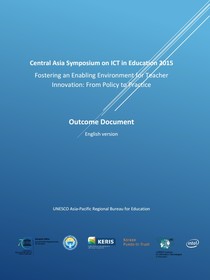What is a Learning Management System?
This article explains what a Learning Management System is and discusses why it is a useful tool for teachers and educators. The article also discusses arguments against the use of Learning Management Systems and why teachers cannot rely solely on this tool to manage e-learning.
December 2006

Teachers using ICT tools to enhance teaching and learning.
A Learning Management System (LMS) is a software package that helps teachers and educators to manage learning content and resources, and to deliver them to students. Usually an LMS is web-based so that students can access learning content anywhere and any time. An LMS enables teachers to manage large numbers of students, instructors and courses, and provide online forums.
Apart from using an LMS to deliver e-learning courses, schools and training institutions also use an LMS to assist with student registration and sometimes to help with competency management, skills-gap analysis, certification, virtual classes and resource allocation (textbooks, instructors, etc.).
An LMS can be used on any computer and can be used to assist just one teacher to manage one course, or can be used to manage the e-learning content and delivery for several teachers and thousands of students.
There is a difference between a “Learning Management System” (LMS) and a “Learning Content Management System” (LCMS). A LCMS is used to facilitate the organization of content from authoring tools, and presentation of this content to students via the LMS.
While most LMS are commercially developed, there are also several free and open-source (FOSS) systems. One free LMS is Moodle. According to the Moodle website, this software package is a “Course Management System”, based on social constructionist pedagogical principles, which is designed to help educators create effective online learning communities. Moodle can be used by teachers to create web-based courses. Such courses generally consist of several lessons, with each lesson including reading materials, activities (including tests and projects) and interactive elements to encourage students to engage in group work.
There are limitations, however, as to how useful an LMS can be, and they are not a universal remedy for managing everything related to e-learning.
While an LMS is generally agreed to be a very useful administrative tool, some argue that because an LMS offers so many tools and options, it can be very confusing for students to use. These critics of LMS argue that more effort needs to be put into designing the interface so that the users (students) can more easily utilize the tool to enhance their learning. These critics recommend that an LMS be designed with the teachers’ and students’ needs in mind.
Others argue that while an LMS is useful in delivering content to learners, it is not always an effective tool for encouraging interaction between students. Therefore, for some aspects of course delivery, it may be better to use web-based “social software” such as wikis, blogs and skype, rather than an LMS, particularly if the type of subject being taught involves exploratory, constructivist thinking and learning.
In addition, some critics argue that an LMS is not suitable for all learning styles. These critics argue that LMS do not cater to the diversity of types of intelligence and the diversity of learning styles that exist. These critics also argue that most LMS provide knowledge in a sequenced, linear, one-way, managed way, which restricts the ability of learners to learn in the ways that best suit their needs.
Many educators believe that while an LMS can be very useful for administrative tasks and for certain learning functions, this one tool cannot address all aspects of learning. Teachers and educators therefore need to have an array of tools and choose the relevant tool for the required task.
Further information:
- Wikipedia: Learning Management Systems
http://en.wikipedia.org/wiki/Learning_Management_System - Moodle
http://moodle.org - "Quit Slammin the LMS"
http://weblogs.elearning.ubc.ca/vschools/archives/2004_11.html#014995 - "Learning Management Systems: The wrong place to start learning"
http://www.elearnspace.org/Articles/lms.htm - Actively using the internet and social software for modern e-learning
http://www2.unescobkk.org/education/ict/v2_2/detail.asp?id=66709
Related articles:
- "Blogs and Wikis – Are they useful in schools?"
http://www.unescobkk.org/index.php?id=5323
Related links:
- "Free and Open Source Software"
http://www.unescobkk.org/index.php?id=1531


